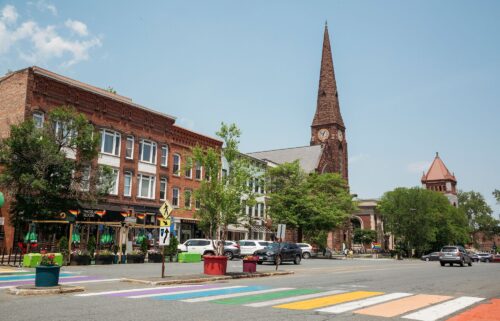More is more: Maximalism is making interior design fun again
By Nina Milhaud, CNN
(CNN) — Since the birth of modernism more than a century ago, the ethos of “less is more” — a motto famously adopted by German architect Ludwig Mies van der Rohe — has become synonymous with sophistication.
And nowhere was this more evident than in our homes, where the popularity of Scandinavian- and Japanese-style interiors (not to mention our short-lived obsession with “tidying expert” Marie Kondo, whose de-cluttering methods swept the world during the pandemic) reflected values of simplicity, restraint and purpose over excess and decadence.
In recent years, however, a growing number of designers and homeowners have turned to striking colors, patterns and textural juxtapositions. Bold, expressive and extravagant, this maximalism (as opposed to minimalism) is, in many ways, the antithesis of the clean lines and muted color palettes that have dominated contemporary home decor.
And it’s a style rooted in an altogether different philosophy: that more is more.
Although the term only emerged in reaction to modern minimalism, it has roots in the decorative styles of the 17th and 18th centuries, when Baroque and Rococo flourished in Europe. Often associated with the very wealthy — think Louis XIV’s exuberant Palace of Versailles — the aesthetic of excess has come in and out of fashion, resurfacing in the Victorian era and later being entwined with movements like Art Nouveau and Postmodernism.
Perhaps inspired by the rise of social media and a backlash against recession-era frugality, the style appears to be enjoying a resurgence.
New book “Living to the Max: Opulent Homes & Maximalist Interiors” pays homage to maximalism through the lens of almost 30 projects — mostly private homes, alongside a handful of boutique accommodations — and the stories, influences and creative processes of the people behind them. From fashion designer Rosita Missoni’s exuberant Milan apartment to burlesque icon Dita Von Teese’s glamorous and theatrical Hollywood home, the glossy title demonstrates that maximalism is often defined not by set rules, but by the eccentricity and eclecticism of inhabitants.
Design as self-expression
Interior designer Matthew Williamson’s Mallorca home is a case in point. Rich in pastel hues and floral prints, it teems with chandeliers, gilt-framed mirrors and Moorish mosaic walls that reflect its owner’s exuberant, joyful approach to design.
“I think I’ve always been a maximalist at heart,” Williamson said via email. “I’ve been forever drawn to things which have a pattern, patina, interesting texture or color, and items which seem to tell a story. Ultimately our homes are, or can be, a reflection of our personalities and our tastes.”
For jewelry designer Solange Azagury-Partridge, whose cottage in Somerset, UK is also featured in “Living to the Max,” maximalism is — unlike its opposite — a medium for self-expression.
“Minimalism requires one to adhere to a strict way of seeing and living,” she said. “It’s a strong and brave point of view, but (one that) allows for no chaos or deviation. Isn’t your home the place to feel the freest to express yourself? That’s why maximalism works so well and will always be relevant.”
Many of the designers featured in the book gladly adhere to — and associate their work with — the maximalist movement. But some, such as Edinburgh-based designer Sam Buckley shun the label (albeit while embracing some of the ethos it represents).
“Though I appreciate that some of my designs may touch upon some sensibilities associated with maximalism, it’s not something that I’ve really thought about before,” Buckley told CNN. “I seek inspiration in so many different things that I find it hard to label my work as any one style, except radicalism, perhaps.”
Fun, playful and sophisticated, Buckley’s Edinburgh home pairs his extensive art collection with a mixed-era furnishings and quirky decor items. In contrast, the apartment he created for game designer Miss Carey (also featured in the “Living to the Max”) draws inspiration from American 1960s “supergraphics”. Although the two homes are aesthetically different, both are characterized by Buckley’s fearless use of color.
“Whereas I prefer the observed simplicity of minimalism, what often lets it down is the use of color,” says the designer. “I think maximalism is a great antidote to the often-seen, boring gray or beige color schemes that rule minimalism.
“But I don’t see why we can’t have more minimalism with better use of color, and that’s what I’m really advocating for.”
“Living to the Max: Opulent Homes & Maximalist Interiors,” published by Gestalten, is available now.
The-CNN-Wire
™ & © 2023 Cable News Network, Inc., a Warner Bros. Discovery Company. All rights reserved.


